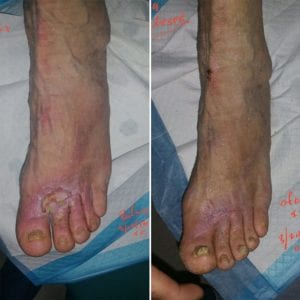Authors: Back Kim MD, Nay Htyte MD & Tae An Choi, ANP-BC
Heart Vein NYC, New York, New York
Chronic Venous Ulcer: 46-Year-Old Man Suffering from Recurrent and Recalcitrant Venous Ulcers (Sores).
 Venous stasis ulcer: shallow ulceration with a macerated (soften skin by soaking in excessive fluid) border, an exudative reddened base, and surrounded by pigmented skin (brownish skin change due to the deposit of blood materials, such as fibrin and iron, and chronic inflammatory process of the tissue1).
Venous stasis ulcer: shallow ulceration with a macerated (soften skin by soaking in excessive fluid) border, an exudative reddened base, and surrounded by pigmented skin (brownish skin change due to the deposit of blood materials, such as fibrin and iron, and chronic inflammatory process of the tissue1).
A forty-six-year-old man suffering from recurrent, poorly healing and painful ulcers (sores) on feet and ankles for many years. He doesn’t have any other medical conditions such as diabetes or peripheral artery disease. He is a non-smoker. Due to his wound and associated venous symptoms such as leg swelling, heaviness, and pain, he had to be on work-leave and had to give up recreational activities and hobbies. He was treated with compression stockings and wound treatment in the local wound facility. Unfortunately, he only achieved temporary healing and failed to prevent remitting ulcers.
As noted in the before picture (left), there is a venous stasis ulcer with macerated (soft, wet skin due to soaking in excessive fluid) border, an exudative reddened base and surrounded by heavily pigmented skin (brownish skin change due to deposit of blood materials such as fibrin and iron and the chronic inflammatory process of the tissue1.)
Chronic venous ulcers are a debilitating condition that often substantially impact the quality of life of those affected. Due to its recalcitrant nature and tendency to recur, in most of cases, conventional treatments often fail to heal or prevent ulcers. Venous ulcers and associated venous symptoms often restrict the mobility. As a result, work productivity and even ADL (activities of daily living) are substantially impaired, like in our patient’s case.
There are many well-described etiologies for non-healing ulcers resulting from venous disease. Chronic venous insufficiency due to incompetent valves, post-thrombotic syndrome, ilio-caval obstruction (blockage in belly/pelvic vein) or a combination the aforementioned scenarios are examples of such conditions. Genetics and lifestyle also play an important role in developing and remitting venous ulcers.
The patient was treated with Endovenous Laser Ablation also known as EVLT, at Heart Vein NYC. Right picture was taken 2 weeks after the procedure. The patient was very happy with how fast the ulcer has healed and he can finally return to his daily activities and work without any limitation. On his most recent follow-up visit, 12 months after intervention, he had significant improvement of his ulcer with complete resolution of symptoms.
References:
- DA Broszczak, ER Sydes, D Wallace, TJ Parker. Molecular Aspects of Wound Healing and the Rise of Venous Leg Ulceration: Omics Approaches to Enhance Knowledge and Aid Diagnostic Discovery. The Clinical Biochemist Reviews 38 (1), 35




